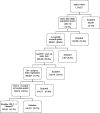Risk of major adverse cardiovascular events associated with elevated low-density lipoprotein cholesterol in a population with atherosclerotic cardiovascular disease with and without type 2 diabetes: a UK database analysis using the Clinical Practice Research Datalink
- PMID: 38030254
- PMCID: PMC10689406
- DOI: 10.1136/bmjopen-2022-064541
Risk of major adverse cardiovascular events associated with elevated low-density lipoprotein cholesterol in a population with atherosclerotic cardiovascular disease with and without type 2 diabetes: a UK database analysis using the Clinical Practice Research Datalink
Abstract
Objectives: To estimate the 12-month probabilities of major adverse cardiovascular events (MACE) and non-cardiovascular death in patients with atherosclerotic cardiovascular disease (ASCVD) and elevated low-density lipoprotein cholesterol (LDL-C).
Design: A retrospective database analysis.
Setting: UK primary care.
Participants: Patients were selected from the Clinical Practice Research Datalink (Aurum) linked to Hospital Episode Statistics inpatient and Office of National Statistics mortality datasets. Patients with an ASCVD diagnosis between 01 January 2010 and 31 May 2018 and LDL-C ≥2.6 mmol/L were selected.
Primary outcomes: Primary outcomes were 12-month risk of (1) MACE (composite of revascularisation, unstable angina, non-fatal myocardial infarction, non-fatal stroke and cardiovascular death) and (2) non-cardiovascular mortality. Kaplan-Meier survival analysis estimated the probability of each outcome. A Cox proportional hazards model explored covariates associated with MACE.
Results: Of 102 245 study patients, 16 501 (16.1%) had a diagnosis of type 2 diabetes (T2DM). 65.5% of those with and 49.9% of those without T2DM had a lipid-lowering therapy (LLT) 6 months prior to index diagnosis. Twelve-month probability of MACE was 7.9% for non-T2DM and 11.8% for T2DM. LDL-C was significantly associated with risk of MACE (HR=1.19 (95% CI 1.16 to 1.22) per 1 mmol/L). History of acute coronary syndrome, other coronary heart disease, stroke and T2DM significantly increased the risk of MACE. Ezetimibe (0.88 (95% CI 0.79 to 0.99)) and low-intensity statins (0.88 (95% CI 0.79 to 0.97)) were associated with reduced 12-month MACE risk.and low-intensity statins 0.88 (95% CI 0.79 to 0.97) CONCLUSION: We confirmed the association between elevated LDL-C and MACE. Many patients with ASCVD and elevated LDL-C were untreated with LLT. With the increasing demands on general practitioners, initiatives aimed at improving identification and treatment of at-risk patients within primary care should be considered.
Keywords: Low-density lipoprotein cholesterol; Major adverse cardiovascular events; atherosclerotic cardiovascular disease; lipid-lowering therapy; type 2 diabetes.
© Author(s) (or their employer(s)) 2023. Re-use permitted under CC BY-NC. No commercial re-use. See rights and permissions. Published by BMJ.
Conflict of interest statement
Competing interests: AD is an employee of Novartis UK, and RL is an employee of Novartis AG, Switzerland. CLM and TB are employees of Human Data Sciences, a research consultancy that receives funding from a wide range of organisations including those from the pharmaceutical industry. Human Data Sciences received funding from Novartis UK to conduct this study. TM has received industry sponsorship for personal financial gain from AMGEN, Daiichi Sankyo, Novartis and Sanofi-Aventis. EH has received industry sponsorship for personal financial gain from MGEN, Daiichi Sankyo, Novartis and Sobi.
Figures
References
-
- Hans-Willi P. Low density lipoprotein cholesterol and coronary heart disease. Eur Cardiol Rev 2005;1:1–16. 10.15420/ecr.2005.1c - DOI
-
- Baigent C, F, Catapano AL, Koskinas KC, et al. . ESC scientific document group. 2019 ESC/EAS guidelines for the management of dyslipidaemias:lipid modification to reduce cardiovascular risk. Eur Heart J 2020;111:88. - PubMed
Publication types
MeSH terms
Substances
LinkOut - more resources
Full Text Sources
Medical


